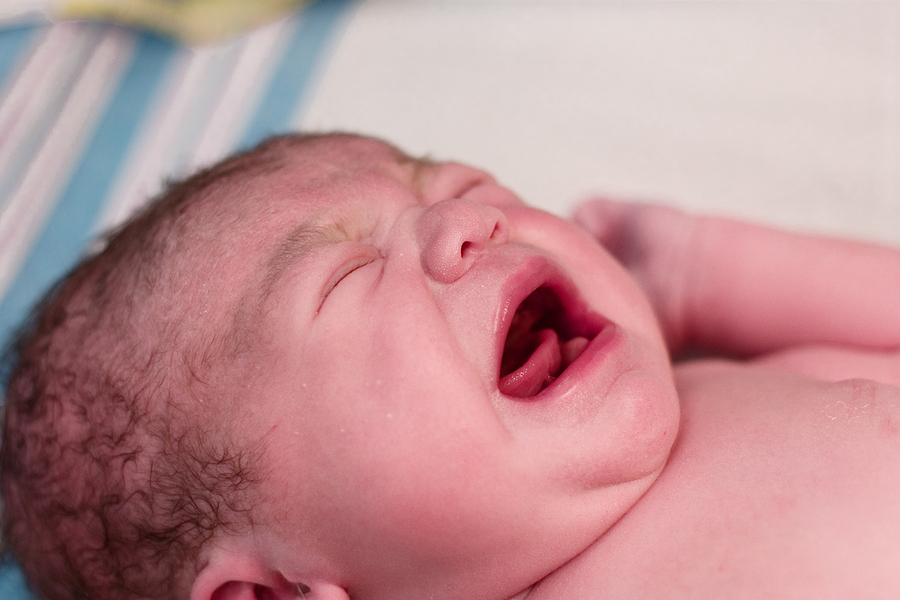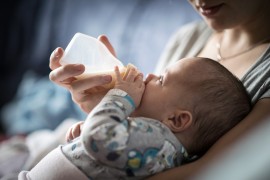The first time I really “got”, on a visceral level, that there is something very wrong with leaving a baby to cry was at a dinner party around a year before my son was even a twinkle in my eye.
I was 27 at the time, and hadn’t been around babies or small children for years as none of my close friends nor family members had them.
The tiny five-month old son of the hosts had been put to bed in this massive Kensington house on four levels, and when I went upstairs to the bathroom I heard his cries coming from the nursery.
Without a second thought, I scooped him out of his cot and took him downstairs.
His father, who was at the stove, was obviously annoyed. “I’m putting him back to bed,” he told me, as he exited the kitchen with the distressed infant. “We’re teaching him to sleep through the night.”
And a minute later he reappeared, having left his little son to cry alone.
Although you couldn’t meet a nicer man than this one – a very devoted father who was only doing what he thought was right – I sensed on a deep level that this was not right.
But it was only when I had my own son, and followed my instincts in raising him, then started to read about attachment parenting, that I really understood why.
The article below is one of the best summaries of that I’ve ever read of that. It’s by Veronika Sophia Robinson, editor of The Mother magazine.
And for those who wish to parent not in the way that is most conventional, nor most convenient, but in the way that best meets the child’s needs, I can think of no better source of information than this very special publication.
It covers fertility awareness, conscious conception, sacred birth, attachment parenting, full-term breastfeeding and natural immunity and as far as I’m concerned, it is essential reading for every pregnant woman, anyone even contemplating having kids, and every parent.
There’s more I want to say about this treasure. That’s coming soon, but for now I will leave you with Veronika’s wise words.
Crying and babies, by Veronika Sophia Robinson
With respect to the new fad of following the Aware Parenting technique of allowing babies to cry, The Mother magazine presents the following facts:
It used to be that when babies were born, they were hung upside down and their bottom was smacked. The idea behind this barbaric thinking was to open their lungs and get circulation going. A gentle and conscious parent would, instead, massage the baby’s skin.
It has been proven (as if an intuitive parent needs proof) that it is physiologically harmful for an infant to cry. This happens on many levels. Firstly, it can cause hoarseness. It reduces blood oxygen levels, dramatically increases the heart rate, disturbs digestion and can lead to fainting. Crying drains a baby’s energy.
The hormone cortisol floods the bloodstream. This negatively impacts on the developing brain. Other negative risks include distress on the respiratory system, breathing troubles, puncturing of the lungs, intra-ventricular haemorrhage.
When we allow our baby to cry unnecessarily, we are teaching it negative socialisation skills. It is here that our infant learns that its caregiver doesn’t in actual fact ‘care’. As a parent, when we allow our child to cry without attending to their needs, we become detached emotionally. All the traumatic states listed above in turn lead to our child having a delayed (psychosocial) adaptation to life after birth.
Our baby, when left to cry, will make poor eye contact after such distress and may not breastfeed as effectively. He is, in essence, shutting down to the relationship with the caregiver.
Hard crying leads to poor learning, and affects sleep patterns. If you view a good cry as positive for your infant, then you are not realising that the sleep induced state it brought on is in fact, a response to stress. This is NOT healthy or safe. Be aware that this negatively affects your baby’s organs and internal systems.
The purpose of a baby’s cry is to alert its mother, and ideally, if she is in tune with her baby, for her to feel upset, and attend to her baby. This is a NORMAL, natural and biologically designed response. It should make the mother’s heart rate and blood pressure increase. Her nipples should become erect, and milk let down will occur.
Crying is designed to alert a baby’s mother to danger. In our culture there is far too much crying. An in-tune mother will not need her baby to cry. She will see and hear her baby cue her for food, nappy, sleep. And she will respond by cuddling, or by changing the baby’s position; feeding or getting him to sleep.
At one extreme of parenting, we have the barbaric Gina Ford style which encourages complete distancing between parent and child. And then we have the Aletha Solter style promoted to attachment parents, ironically. Her style states that if you love your child and stay near her, she can cry all she likes. Both are completely ignorant and out of touch with an infant’s needs. Both are based on utter selfishness.
While crying may be healing for adults, this does not mean it is the same for infants. Infants are non-verbal and have not developed their other systems; adults have.
The Aware Parenting approach is a shortcut to eliminating the intuitive tie between mother and child. It leads to separation and does nothing to maintain bonding between mother and child. The practice suggested by Aletha Solter is passive, detached and creates emotional separation. As mammals, this is completely contrary to our biological evolution and needs.
Many studies have shown that this very act of emotional separation and detachment can lead to violence later on in life. It is emotional neglect. When we do this to our children, we are teaching them, in a non-verbal way, that it is ‘normal’ and therefore ‘right’ to not feel the pain and hurt of other human beings.
We fool ourselves if we believe that not attending to the needs of a crying baby is any different than if we were to leave them crying in a room alone. Babies who are denied comfort through the breast will be deficient in tryptophan.
An infant does not want to cry. It cries so that its mother will come and stop the crying. It is a late call to needs. Whatever the needs: comfort, heat, breast milk, suckling for comfort, the baby is calling you to relieve its problems. It relies on you.
By forcing a baby to self-soothe we are inadvertently interfering with the development skills. They are compromised.
Our culture has a high rate of thumb sucking and the need for dummies and pacifiers. Cultures which allow babies to nurse on cue, have no incidence of thumb sucking. When we meet the needs of our infants, they will have no need to suck fingers, thumbs, artificial objects or even more sadly, to bang their heads, self rock, body rock or head roll. Most humans would be horrified to see these actions occurring to animals kept in captivity. Yet we don’t notice it in our own children?
It is so easy to recognise when our baby needs attention. We do not need to wait for her to cry. Look and listen to her fidgets, grimaces, fussing and agitation. This is her way of communicating. Some babies never need to cry. When we truly care for our baby, nurse on cue (not on demand), and carry the baby so they have sensory stimulation, they have very little reason to cry.
It can take just over a minute for the unmet needs of a baby to go from a small cry to a crying scream of pain. Quick and intuitive responses by a mother lead to happy, contented babies.
Many studies have shown that this very act of emotional separation and detachment can lead to violence later on in life. When we do this to our children, we are teaching them, in a non-verbal way, that it is ‘normal’ and therefore ‘right’ to not feel the pain and hurt of other human beings.
When we allow our baby to cry unnecessarily, we are teaching it negative socialisation skills.
Further reading:
Anderson, G.C., Crying in transitional newborn infants: Physiology and developmental implications.
Dinwiddie R, Patel B.D., Kumar S.P., Fox W.W., The effects of crying on Arterial Oxygen tension in infants recovering from respiratory distress
Drane D., The effects of dummies and teats of oro-facial development
Fagen, J.W., The effect of crying on long term memory in infancy
Ko, M., Crying is not good for babies
Prescott, J. W., Essential Brain Nutrients; Breastfeeding for the development of human peace and love and Deprivation of physical attention as a primary process in the development of physical violence
Woolridge, M. W., Baby controlled breastfeeding; Biological implications
Visit The Mother magazine’s website for further information.






awesome article and so very true
View Commentanother really great article is here: http://www.janetlansbury.com/2011/09/7-reasons-to-calm-down-about-babies-crying/
View CommentWith four kids, three of them raised by attachment parenting, I can vouch that every word of this is true.
View Comment